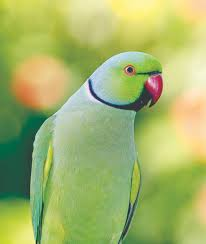Indian Ring-Necked Parakeet

Description
The Indian Ring-Necked Parakeet (Psittacula krameri), also known as the rose-ringed parakeet or ring-necked parakeet, is a medium-sized parrot in the genus Psittacula of the family Psittacidae that has a very wide range.
The rose-ringed parakeet is sexually dimorphic. The adult male sports a red and black neck ring and the hen and immature birds of both sexes either show no neck rings, or display shadow-like pale to dark grey neck rings. Both sexes have a distinctive green colour. Rose-ringed parakeets measure on average 40 cm (16 in) in length, including the tail feathers, a large portion of their total length. Their average single-wing length is about 15 to 17.5 cm (5.9 to 6.9 in). In the wild, this is a noisy species with an unmistakable squawking call, and captive individuals can be taught to speak. It is herbivorous and not migratory.
One of the few parrot species that have successfully adapted to living in disturbed habitats, it has withstood the onslaught of urbanisation and deforestation. As a popular pet species, escaped birds have colonised a number of cities around the world, including Northern and Western Europe. Since the population appears to be increasing, the species was evaluated as being of least concern by the IUCN in 2012, but its popularity as a pet and unpopularity with farmers have reduced its numbers in some parts of its native range.
The genus name Psittacula is a diminutive of Latin psittacus, "parrot", and the specific krameri commemorates the Austrian naturalist Wilhelm Heinrich Kramer.
Scientific Name
Psittacula Krameri Manillensis
Country Of Origin
India
Size
Life Expectancy
Noise Level
Moderate
Talk / Trick Ability
Fair; can be good mimics
Characteristics
The most popular and widely kept of the Psittacula species, the Indian ring-necked parakeet is not known for its affectionate manner. Indian ring-necked parakeets can make excellent companions if owners handle, interact, play and talk to them daily.
Behavior / Health Concerns
Indian ring-necked parakeets can develop social phobias with regular interaction and handling. Indian ring-necked parakeets enjoy chewing, so provide soft wood toys. Generally not picky eaters, provide an Indian ring-necked parakeet a varied diet with plenty of fruit, vegetables, green and whole grains. Males have a more distinct rose collar and facial markings than the females. They have a narrow black stripe on the mandible under the throat and a black lower mandible. Female Indian ringnecks do not have the colorful neck rings or facial markings found on adult males. Female also tend to be more dominant than males.